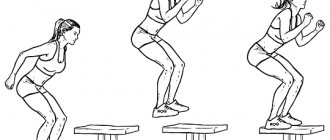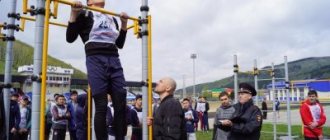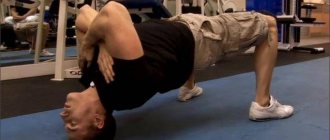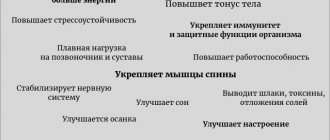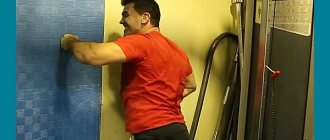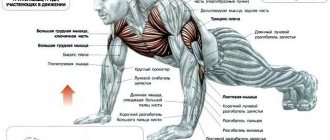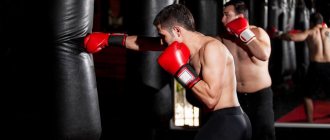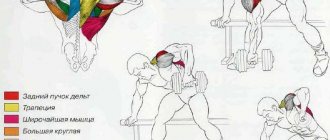Since ancient times, people have learned to turn their natural means of transportation, namely their legs, into a dangerous weapon. This is especially true for Thais, who, thanks to such blows, can compensate for their weaknesses in the form of short stature and thin build.
These days side kicks
Even mixed martial arts fighters borrow from Thai boxing, since they are considered one of the most effective, due to the fact that the fighter invests his body. This transfers more inertia into the blow and this type of interaction between the legs, hips and core muscles forms a very powerful movement of the legs.
Side kick in Muay Thai
The striking surface is the shin, not the foot. This further increases strength since the shin is much stronger than the foot. With proper training, such a blow can break a baseball bat, let alone ribs.
Blows of such force are delivered as if carried forward, so you can often see how, after a fighter misses, the leg flies further and the fighter has to turn 360 degrees to return back to the stance.
The side kick can be divided into 3 levels:
- The lower level is a “low kick”, the blow is delivered to the outer or inner surface of the thigh.
- The middle level is “ middle kick
”, hitting the body on the ribs or liver. - The top level is “high kick”, the blow is delivered to the head.
To understand the principles of side kicks in Muay Thai
It is advisable to start studying with “middle kick”.
For such a blow, it is advisable to have a more or less normal stretch to protect the ligaments and joints during practice.
Variety of strikes
How to throw a low kick? Strikes can be delivered from a place, with a sharp entry into the combat distance, and while retreating. But the most important thing is that only the prepared part of the leg should come to the point of contact. Initially, it is the accuracy of the strike that is needed, and strength and speed are secondary.
There is simply no one way to strike. It can be carried out with different inclinations and heights of leg lifting. It is better to hit the inner part of the knee or thigh with an inclination to the vertical of 45 degrees. In this case, the shin will come into contact at the required angle of 90 degrees. But a blow to the outside of the thigh is no less effective. Moreover, it will be very painful if hit from top to bottom. An unprepared person can be made to lose coordination with one low kick, and if he hits his supporting leg, he can even be knocked to the ground.
To understand the “middle kick” technique, there is a good introduction exercise:
Go to a wall or any similar object, turn your left side towards it and lean on your left hand for balance. Turn your foot outward so that your toes point toward the wall. Try to keep your body straight. Raise your left leg, bent at the knee, towards your body and clasp your shin with your free hand. The hand will hold your leg. While in this position, without straightening your leg, rotate your hip joint, moving your leg to the side and back, keeping it parallel to the floor. Stretch back as much as possible, and then press back to the body. Then pull it back again and press it against the body. So 10-15 times on each leg, several approaches.
This exercise will warm up your hip joint, and also, more importantly, help you understand the principle of a side kick.
.
https://youtu.be/8lmxy4QKLbo
Kickback for everyone
But if you use the Sessia mobile app, you will receive not only cashbacks, but also kickbacks.
Communicate with the world
Sessia is both a marketplace and a social network where you can not only purchase something, but also share with friends and family how you spend your time, what you eat and where you travel. Only you will do this not only with the help of photos, as on Instagram, or posts, as on Facebook, or short messages, as on Twitter.
Advertising on the eyelid How to place
You will talk about your life in an original, but at the same time very honest way - through the publication of your own receipts. Thanks to Sessia, you can not only recommend your favorite restaurants, hair salons and jewelry stores to your friends, but also receive decent cashbacks for it.
Let's spend together
But cashbacks, while very nice, are not the most important feature of the Sessia app. Personal gain is certainly motivating, but it’s still an expense—to get cashback you need to pay for the service. What if you get money without spending a cent? It's possible!
Everyone has colleagues, acquaintances, friends and family. And, in any case, your interests intersect with them. Narek Sirakanyan, founder and President of Sessia, believes that Sessia users should get the maximum benefit from the application. That is why the kickback program was invented - the percentage that is accrued to you from the purchases of friends based on your recommendations.
Double benefit
After you paid, for example, for dinner at a restaurant, your receipt was scanned and you were credited with cashback. A post about this purchase is automatically published in the Sessia Feed. If, for example, your colleague saw this post, he becomes a participant in the loyalty program of this establishment. This means that when visiting the same restaurant, this colleague will receive a cashback, and after scanning his receipt by an employee of the establishment, you will receive a kickback from his purchase.
Blockchain remembers
Thanks to the blockchain technology used by Sessia, all transactions, information about where, who and who invited, as well as user reviews are reliably protected. For example, if you spent 30 US dollars in a beer hall in Brussels, and your friend, having seen your post in the Feed during a boring conference in Hong Kong, decided to drop everything and fly to Belgium for a cool drink, then in the end she will receive the same cashback, like you, and you are a kickback from her order. You can spend the Kicks that will be instantly credited to you on purchases all over the world, as well as withdraw them to a card or gift them to a friend.
Agree, it is not only convenient, simple and clear, but also very profitable. Join Session!
Now let’s proceed directly to practicing the “middle kick”:
We stand in a left-sided stance, lift and bend your left leg at the knee in front of you. Turn the foot of the supporting leg approximately 90 degrees, as in the approach exercise, and at the same time, your right leg should also turn, as when practicing the approach exercise, approximately parallel to the floor. And from here you straighten your kicking leg. After the blow, we bent our leg at the knee and returned to the stance. In this case, the body can lean back slightly, but only slightly. Make sure your hands are near your head.
Now we practice the “middle kick” on the other leg.
Once you have mastered this type of side kick
, you can start learning “low and high kick”.
Jumping jack exercise how to do
This is an energetic jump, which is accompanied by spreading the arms (almost connecting them above the head) and legs. After the jump, we return to the starting position and immediately repeat the entire action.
See also: Fat burning exercises at home
Execution technique, step by step:
- Stand up straight, lower your arms freely along your body, bend your legs slightly at the knees.
- Take a jump, pushing off with your feet apart, approximately slightly wider than shoulder width. At the same time as you jump, raise your arms above your head.
- Dynamically return to the starting position and repeat the exercise the specified number of times. The movements of the arms and legs must be synchronous.
Video of the exercise
As you can see, this is an easy exercise and at the same time effective.
What is the benefit of jumping
The main advantage of the jumper is an increase in heart rate, which means supplying more oxygen to the muscles. Exercise also makes us more flexible. In addition, by performing jumps, we train the entire body and use different muscle groups.
Like any physical activity, jumping releases endorphins, which are the feel-good hormone and also a natural pain reliever. Muscular endurance and strength increase, metabolism accelerates, as a result of which we lose weight.
How many calories does jumping jack burn?
In fact, the jumper increases your heart rate and also speeds up your calorie burning. A woman weighing 58 kg will burn 130 kcal during a 30-minute exercise at a moderate speed, and 237 kcal during vigorous jumping.
Fat burning efficiency can be increased by adding variety to your jumps, such as doing a half squat after jumping instead of returning to the starting position. The jumping jack is one of the most recommended exercises for burning fat.
Jumping jack for weight loss
The jumping jack is an ideal exercise that can be used in the form of interval training, which is an effort of variable intensity that burns fat more effectively than training at a steady pace. In the beginning, for example, walk at a brisk pace for 5 minutes, then do as many jumping jacks as possible for two minutes, and then return to brisk walking again. You can also use the exercise as part of a larger interval exercise.
See also: Tabata workout, exercises for weight loss.
Low kick practice
If you use this striking technique without practice, you risk injury. Try not to fall out of balance. First you should stuff the drumstick.
To do this you will need a pear (bag) and shields. For what? They reduce the risk of damage to body parts by softening the blow.
With each workout you need to increase the strength of the low kick, when the pain goes away you can continue training without the pads.
When practicing a low kick with a partner, avoid hitting your opponent’s knees so as not to inadvertently injure him. A correctly placed and practiced low kick will be an effective way to temporarily throw your opponent off track.
Call
Kicks are a very formidable weapon. The force of a kick is several times greater than the force of a hand. A correctly executed blow can cause much more damage to an opponent than the hand can do. Not only strength and speed depend on the correctness of the blow, but also protection from a possible counterattack by the opponent. In point fighting, the front leg works predominantly; the back leg works in rare cases and mainly in counterattacks. This is due to the fact that striking with the back leg will occur with a turn of the whole body in the direction of the blow. Experienced opponents will quickly react to this action and launch their own quick, anticipatory counterattack.
Due to their length and power, kicks are much more effective than punches. However, they are more complex in terms of technical execution. To better use your legs, you need to have good stretching, train and develop the muscles and give them elasticity through static exercises, working with rubber, on the paws and specialized equipment. Before considering the technical execution of kicks, you should pay attention to common errors and features.
The main mistake in kicking is the understep. Step-up strikes are very common in ring disciplines. In point fighting, they need to be applied unnoticed, respectively, with a minimum number of actions. The understep is very noticeable to the opponent, and even if he does not get ahead of him with his attack, he certainly will not allow him to get to him. Another problem when throwing a kick is the loss of stability, as a result of which the blow becomes not so strong and vulnerable. The supporting leg should be slightly bent in order to absorb the blow and be able to push off to a long distance. The specifics of performing kicks in point fighting include the tilt of the body at the moment of the execution itself. Due to the deeper tilt and rotation of the hips, the range of the strike increases, which is a very important point for winning the fight.
One of the main elements of a kick is the extension of the knee and the placement of the feet. At the moment of raising the leg, the foot of the striking leg should be with the heel forward (towards the opponent). The striking leg first bends at the knee and rises as high as possible. The knee should be as bent as possible and close to the front shoulder. The foot of the striking leg is tense and ready to strike at any moment. The toe of the foot is raised up so that the opponent can see the entire sole from heel to toe. This position of the leg when striking will allow you to deliver a variety of kicks, and it will be difficult for your opponent to understand what kind of blow the opponent wants to deliver at the moment. The defense must also be placed correctly. The hands are in the same position as in a normal stance, and due to the high raised knee and the foot, which is in front of the face, the opponent will not be able to make a counterattack in the form of an overlay or put his leg on the opponent’s leg. Raising the knee to a high level is only possible with good stretching.
After the leg has made preparatory actions for the strike, it is time to extend the leg and deliver the strike itself.
In point fighting there are the following main kicks: front kick, roundhouse kick, side kick, ex kick, hook kick, jumping kick, foot kick.
How to train and develop automatic boxing skills
Developing automatic boxing skills from learned techniques into automatic reflexes takes quite a long time and requires effort and patience. Simple exercises for working on the paws to develop automatic skills are presented below:
Chase and throw the jab
The coach’s task is to raise his right or left hand only for a second, and then lower it. The boxer's job is to follow his trainer as he moves around the ring; as soon as his paw appears, the boxer must immediately throw the jab. This exercise helps develop reaction reflexes so that the boxer is always ready to throw a jab while moving around the ring, keeping the correct distance from his trainer.
Two, Dive Under Counter-Left Hook
The trainer should place his paws under the deuces while the boxer follows him around the ring. The trainer should then try to catch the boxer off guard by trying to land a counter left hook to the boxer's head after the boxer has thrown a deuce. When the boxer sees this, he must dive under the left hook.
Circular strikes
In ordinary boxing, such liberties are not allowed, but kickboxing, as a synthetic martial arts, creatively borrowed this effective blow from the arsenal of karate (where it is called “uraken” and is highly recommended for use when the enemy is on the side, or even behind you).
Description of movement
A circular strike is also called a backhand strike, since this is exactly how it is carried out: it is as if you are swinging away from the enemy. The attacking arm moves from the chest to the side and outward, simultaneously straightening at the elbow and extending in line with the shoulders. The combination of two circular movements (the forearms around the elbows of the entire arm around the shoulder, sometimes also rotating the fist around the wrist joint) with the rotation of the body stores powerful energy, which is released when the target is hit. As a rule, this is the head (usually the cheekbone or ear); occasionally, a circular blow can hit the solar plexus.
Adviсe
With a circular strike, as perhaps with no other, it is important to be able to concentrate efforts and “pick up” the attacking limb with timely and quick muscle tension. The fact is that the complex of rotational movements tends to completely straighten the striking arm, and in combat this can turn out to be very dangerous (if, say, a well-timed block is placed in the path of the straightened elbow). You can avoid such surprises by turning your body faster - then the rotation of the arm will lag behind the rotation of the shoulder, and the target will be hit when the arm is not yet fully straightened.
Nevertheless, during training you should also practice the option of almost completely straightening the striking arm. It can come in handy when you have to catch up with a retreating enemy with such a blow.
The striking surface in a circular strike can be the back of the fist, but the rules do not prohibit the strike being executed so that the target is also hit by the lower part of the fist (the bent edge of the palm).
A special way of delivering a circular strike - with a turn (through the back)
With this movement, your body makes a full rotation around a vertical axis, at the end of which the hand, using the stored rotational energy, strikes.
Here it is important not to leave your own back unprotected, so the head must at some point get ahead of the rotation of the body: keep your eyes glued to the enemy as long as your neck endures, and then quickly turn it a full turn and then catch up with the body.
Sometimes a circular strike with a turn gives a wonderful result if it is carried out in a jump - for example, after showing the enemy that in fact they are going to hit him with their hands and not with their feet.
https://youtu.be/f_50Z9J-zBY
Recommendations and rules for a beginner
Below are the basic rules and recommendations that a beginning kickboxer should know in preparation for sparring.
When working with your hands, the main thing is not your hands, but your legs.
Because the successful execution of attacking and defensive actions: strikes, dodges, movements - almost entirely depends on how competently the athlete controls his body, his ability to correctly redistribute body weight between his legs, and such redistribution occurs throughout the entire time the fight lasts.
Hands are like swords, and when striking, they should not slide, but stick.
Therefore, all applied blows - direct or lateral - should, according to the characteristics of their trajectories, not be sliding, but penetrating, and fists, when delivering blows, should always move not in an arc, but in a straight line.
When you strike, defend yourself.
In taekwondo, against almost every blow you can immediately use a retaliatory strike - a counterstrike, and therefore, when attacking an enemy, you need to constantly remember about defense and try to protect yourself as much as possible from possible retaliatory strikes from him, therefore:
The shoulder of the striking hand always covers the chin on one side, the fist of the free hand on the other.
When performing any blow, the shoulder of the beating (strike) hand must cover the chin on one (its) side, and the fist of the free (non-strike) hand must cover the chin on the other (its) side. In this case, the elbow of your free hand should always cover your torso.
Hit, defend yourself immediately.
After performing the blow, the athlete must return his hand, without holding it for a moment, as quickly as he delivered the blow. The return of the hand should occur along the shortest trajectory to a position capable of performing both defensive and attacking actions. The correct return of the hand after a blow in itself provides the athlete with additional protection.
When you hit with your right hand, your body weight is on your left leg; when you hit with your left hand, your body weight is on your right leg.
If the strike is performed with the right hand, then simultaneously with its execution the body weight is transferred to the left leg; if the strike is performed with the left hand, then the body weight is transferred to the right leg in the same way. This transfer significantly increases the impact force.
Insight
What is low kick insight? Such a blow has advantages over a regular one. First, it is much more painful for the enemy. Secondly, blocking it is even more difficult than usual. Third, it is less dangerous for the striker if the opponent blocks.
A good combination is a double punch and insight. The value lies in the fact that after a good insight the opponent remains practically on one leg only. The subsequent low kick simply knocks him down.
Insight, unlike ordinary insight, beats from the bottom up. After the correct insight into the thigh, the opponent’s leg simply “dries up.” It is at this moment that the next blow is made, and ideally on the other leg while the opponent is in a standing position. This causes the opponent to lose balance and fall.
